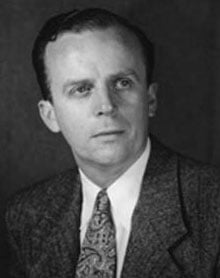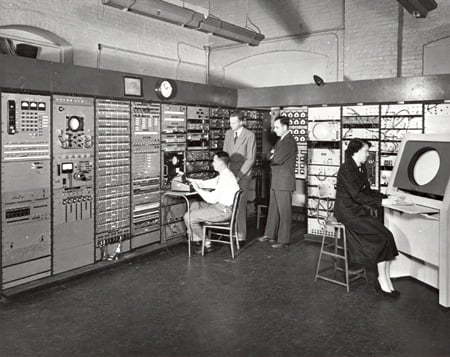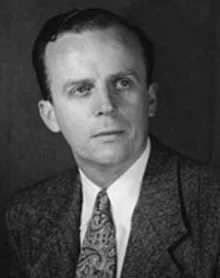
Joseph Licklider
Joseph Carl Robnett Licklider (see biography of Licklider), called also J.C.R. or “Lick”, was an American scientist, an imaginative experimenter and theoretician, who left major marks not only in computer science, but also in psychoacoustics.
In the 1950s, working as an associate professor at MIT (Massachusetts Institute of Technology) and director of the Acoustics Laboratory, Lick got caught up in Project SAGE. It was a crash program to create a computer-based air defense system against Soviet long-range bombers. The computer in SAGE was Whirlwind (see the lower photo), which had been under development at MIT since 1944 and recently had been completed under the direction of Jay Forrester. Other early computers, such as ENIAC, had started out as giant calculators, with an operating style to match: You entered the numbers and eventually got back a printout with the answer. This came to be known as batch processing. Whirlwind, by contrast, had started out as a flight simulator and had evolved into the world’s first real-time computer: It would try to respond instantly to whatever the user did at the console. The challenge was to prove that a computer could take the data coming in from a new generation of air-defense radars and display the results rapidly in a meaningful form.

The Whirlwind computer
Lick headed SAGE’s human-factors team, and he saw the project as an example of how machines and humans could work in partnership. Without computers, humans couldn’t begin to integrate all that radar information. Without humans, computers couldn’t recognize the significance of that information, or make decisions.
Developing in 1950s his theories of perception Lick used the analog equipment for generating stimuli, collecting responses, analyzing them, and so on. He found out, however, that analog computers were not flexible enough to help him in his theory-building effort. This disappointment with analog computers marks the beginning of his love affair with digital computers as modeling tools.
In 1957 year he left MIT for the small consulting firm Bolt Beranek and Newman (BBN), as vice president and director of research of the departments of psychoacoustics, engineering psychology, and information systems. His train of thought went into strange new paths. That spring and summer, he kept track of what he actually did during the day, analyzing later the data with shocking results. “About 85 percent of my ‘thinking’ time was spent getting into a position to think, to make a decision, to learn something I needed to know,” he later wrote. He concluded that his decisions on what work to attempt “were determined to an embarrassingly great extent by considerations of clerical feasibility, not intellectual capability.”
This 85% of his research time, devoted to performing routine clerical or mechanical operations ranging from calculating and data plotting to collecting information, are tasks that in principle could be performed better and faster by a computer. Computers, he believed, would rescue the human mind from its enslavement by mundane detail. Human and machine were destined to unite in an almost mystical partnership, with computers handling rote algorithms while people provided the creative impulses. The hope, he said, was that “the resulting partnership will think as no human brain has every thought and process data in a way not approached by the information-handling machines we know today.” Lick found this vision of human-computer symbiosis so compelling that standard psychology could no longer compete.
Thus he switched fields, becoming an active member of the computer community. In March 1960 Lick published a seminal paper — Man-Computer Symbiosis, where he formulated a new vision of computing. He described a machine that humans could relate to in the manner of “a colleague whose competence supplements your own”—a friend who could help when the problems got too hard to think through in advance. Such problems “would be easier to solve” he wrote, “and they could be solved faster, through an intuitively guided trial-and-error procedure in which the computer cooperated, turning up flaws in the reasoning or revealing unexpected turns in the solution.”
Real-time computers were still a rarity in the 1960s, and far too expensive for personal use. Therefore, Lick concluded, the most efficient way to use this technology was to have the computer “divide its time among many users.” This certainly was not an original idea; such “time-sharing systems” were already under development at MIT and elsewhere. Lick however followed that notion to its logical conclusion, describing an online “thinking center” that would “incorporate the functions of present-day libraries.” He foresaw “a network of such centers, connected to one another by wide-band communications lines and to individual users by leased-wire services.” Sounds like ARPANET, yeah?
Lick also saw a desperate need for better ways for human-computer interaction. Punch cards and printouts were, he wrote, hopelessly impoverished relative to human communication via sight, sound, touch and even body language. Lick proposed solution: a desk-sized console that would function much like today’s personal computer, equipped with voice and handwriting recognition. He described a display surface “approaching the flexibility and convenience of the pencil and doodle pad or the chalk and blackboard.”
Lick pointed out the need for reference works distributed via cheap, mass-produced “published memory”; data storage that could access items by content, and not just by names or keywords; and languages that would allow you to instruct the computer by giving it goals, instead of step-by-step procedures. He also revealed his mixed feelings about artificial intelligence, then in its infancy. He saw it as being potentially very useful but knew far too much about the brain and its complexities to believe that computers would soon be surpassing humans.
In October 1962 Lick became the first director of the Information Processing Techniques Office (IPTO) of the Advanced Research Projects Agency (ARPA) of the Department of Defense and launched a research program after his vision of man-computer symbiosis, including hardware and software requirements for such a symbiosis. The Pentagon had formed ARPA five years earlier in the aftermath of the USSR’s Sputnik as a fast-response research agency, charged with making sure the United States was never again caught flat-footed. Now, ARPA wanted to set up a small research program in “command and control”. This was a critical matter in the nuclear age, and was obviously going to involve computers. And once ARPA director Jack Ruina heard Lick expound upon his vision of interactive, symbiotic computing, he knew he had found the right person to lead the effort. Lick was being offered an opportunity to spend big money (over 10 million USD) in pursuit of his vision of human-computer symbiosis. The IPTO program, initiated by Lick turned out to be very successful, so much so that it has become by now a model for other government-sponsored research programs.
In IPTO Lick formed scattered groups of researchers around the country who already shared his dream, and nurtured their work with ARPA funding. The first major project, supported by Lick, was Project MAC at MIT, founded with Lick’s encouragement as a large-scale experiment in timesharing and as a prototype for the computer utility of the future. MAC (the name stood for both “Multi-Access Computer” and “Machine-Aided Cognition”) would also incorporate Marvin Minsky’s Artificial Intelligence (AI) Laboratory. Other major sites included Stanford, where Lick was funding a new AI group under time-sharing inventor John McCarthy; Berkeley, where he had commissioned another demonstration of time-sharing; Rand Corp., where he was supporting the development of a “tablet” for freehand communication with a computer; and Carnegie Tech, where he was funding Allen Newell, Herbert Simon and Alan Perlis to create a “center of excellence” for computer science. Lick had also taken a chance on a soft-spoken visionary he barely knew, namely Douglas Engelbart, whose ideas on augmenting the human intellect with computers closely resembled his own and who had been thoroughly ignored by his colleagues. With funding from Lick, and eventually from NASA as well, Engelbart would go on to develop the mouse, hypertext, onscreen windows and many other features of modern software.
Lick wanted to create a community in which widely dispersed researchers could build on one another’s work instead of generating incompatible machines, languages and software. He broached this issue in an April 1963 memo to “Members and Affiliates of the Intergalactic Computer Network”. The solution was to make it extremely easy for people to work together by linking all of ARPA’s time-sharing computers into a national system. He wrote: “If such a network as I envisage nebulously could be brought into operation, we would have at least four large computers, perhaps six or eight small computers, and a great assortment of disc files and magnetic tape units—not to mention the remote consoles and teletype stations—all churning away.”
Again to close to what we now call the Internet. This time however Lick didn’t stop there. Clearly enamored by the idea, he spent most of the rest of the memo sketching out how people might use such a system. He described a network in which software could float free of individual machines. Programs and data would live not on an individual computer but on the Net.
A major project on which Lick worked at BBN was a study of future libraries, granted to him by the Council on Library Resources. It was intended to be a five-year effort beginning in November 1961, but it lasted only two years because Lick left BBN in 1962 to become director of IPTO, and even his long-distance supervision of the project had to be terminated a year later. The final report on the project, completed in January 1963, was deemed by the council to be an important contribution deserving of publication in book form. The book Libraries of the Future, published in 1965 by MIT Press, presents a vision of future libraries based on Lick’s vision of man-computer symbiosis.
The first half of the book is similar in structure to his earlier paper. After limiting the scope of Libraries to the body of documents that could be stored in digital form without loss of value and estimating its current size, Lick presents a detailed analysis of the intellectual processes involved in the acquisition, organization, and use of knowledge. This is followed by a description of the structure and usage of the procognitive systems he envisioned, capable of searching the body of documents under user control. Finally, Lick outlines, as in his earlier paper, a research program intended to bring about his vision. The second half of the book reports on the initial steps of the research program carried out as part of the library project.
In 1964 Lick completed his two-year tour of duty at ARPA and became a consultant to the director of research of IBM. At ARPA, program managers traditionally moved on after a year or two to give someone else a chance, and Lick was no exception. But in September 1964, when he left ARPA for the IBM research laboratory, he took care to find a successor who shared his vision. His choice was Ivan Sutherland, a 26-year-old computer graphics genius from MIT’s Lincoln Lab whose doctoral project, Sketchpad, was the ancestor of today’s computer-aided design software.
Lick’s influence would continue to be felt at ARPA for more than a decade. Sutherland’s successor in 1966 would be Robert Taylor, who shared with Lick a background in psychology and who was probably Lick’s most enthusiastic convert to the symbiosis vision. It was Taylor who would inaugurate the actual development of Lick’s proposed computer network, which began operation in 1969 as the ARPAnet and ultimately evolved into the Internet. And it was Taylor who went on to head the computer group at Xerox’s Palo Alto Research Center (PARC), where, during the 1970s, researchers turned Lick’s notion of symbiosis into a working system. When Taylor left ARPA in 1969, he handed the reins to ARPAnet architect Larry Roberts, another computer graphics maven, who had become intrigued with networking after a late-night bull session with Lick.
So, in 1966 Lick returned to MIT to direct Project MAC, and as a professor of electrical engineering and as director of Project MAC, the research laboratory he had been instrumental in establishing in 1963 and which became eventually the present Laboratory for Computer Science. In 1974 he took a year’s leave of absence to return to Washington with the Department of Defense, again as director of the IPTO. Licklider returned to MIT from government service in 1975 and remained there until his retirement in 1985, when he became emeritus professor.
The image featured at the top of this post is ©Unknown author / public domain


